I'm solving an equation with OLS which returns a timing point on an x/y/z surface mesh. I can solve for speed and directionality per the method outlined below. The problem is, my vectors are not parallel to the surface mesh and I'm uncertain of the correct transforms needed to get it in the correct direction.
The literature states:
"For the visualization of the vectors in the 3D geometry ... If only surface data were used in the calculation of the vectors, the conduction velocity vectors were geometrically projected into the plane orthogonal to the surface normals. This constraint corrected vectors pointing inside or outside the surface"
I have no idea how to do that.
Reprex Data:
library(plotly)
library(dplyr)
tri_list <- list(surf_tri = structure(c(1L, 1L, 4L, 8L, 11L, 12L, 17L, 6L,
19L, 13L, 3L, 5L, 22L, 1L, 26L, 18L, 18L, 8L, 21L, 14L, 27L,
4L, 14L, 7L, 6L, 29L, 22L, 16L, 23L, 26L, 3L, 28L, 2L, 13L, 12L,
31L, 33L, 35L, 32L, 28L, 33L, 31L, 20L, 9L, 36L, 12L, 29L, 20L,
31L, 27L, 17L, 26L, 8L, 15L, 9L, 29L, 9L, 35L, 15L, 11L, 16L,
16L, 38L, 31L, 37L, 32L, 24L, 35L, 23L, 23L, 23L, 37L, 10L, 35L,
2L, 4L, 5L, 7L, 10L, 13L, 16L, 18L, 20L, 2L, 2L, 7L, 3L, 3L,
25L, 17L, 27L, 17L, 7L, 2L, 18L, 27L, 28L, 5L, 7L, 1L, 30L, 29L,
30L, 31L, 13L, 5L, 5L, 12L, 14L, 33L, 10L, 25L, 25L, 20L, 12L,
12L, 28L, 36L, 15L, 19L, 4L, 7L, 37L, 4L, 27L, 13L, 36L, 36L,
7L, 16L, 10L, 32L, 16L, 15L, 23L, 30L, 16L, 34L, 34L, 37L, 35L,
24L, 13L, 24L, 26L, 11L, 11L, 38L, 3L, 2L, 2L, 6L, 9L, 14L, 15L,
8L, 9L, 14L, 13L, 21L, 23L, 22L, 24L, 8L, 17L, 15L, 20L, 28L,
6L, 6L, 19L, 4L, 4L, 22L, 16L, 22L, 22L, 32L, 23L, 21L, 28L,
31L, 19L, 34L, 34L, 32L, 26L, 19L, 9L, 33L, 21L, 11L, 11L, 9L,
1L, 9L, 32L, 29L, 29L, 31L, 9L, 8L, 8L, 17L, 33L, 38L, 38L, 38L,
39L, 23L, 39L, 37L, 10L, 38L, 39L, 25L, 26L, 39L, 24L, 38L, 37L,
39L), dim = c(74L, 3L), dimnames = list(NULL, c("V1", "V2", "V3"
))), coordinates = structure(c(1.9194540977478, 11.1435489654541,
5.42491292953491, -1.66259050369263, 7.44240760803223, -6.69524192810059,
-0.0333123430609703, -4.23227882385254, 21.1540908813477, 28.65553855896,
26.0386810302734, 24.6995525360107, 38.495361328125, 22.120174407959,
-2.17373514175415, 0.292593091726303, -11.4042282104492, -10.3343534469604,
17.5129470825195, 11.7786016464233, 9.42895698547363, -1.22890889644623,
23.1779632568359, 31.624174118042, 38.5983734130859, 45.1263847351074,
-11.1577320098877, 12.0059661865234, -2.91624927520752, 0.309472501277924,
30.9889793395996, 42.6134490966797, 23.7120399475098, 26.9033088684082,
30.3514823913574, 7.96694564819336, 31.1637763977051, 31.1527690887451,
25.4455451965332, -61.4243927001953, -56.5476036071777, -45.9739837646484,
-66.2752914428711, -66.6171951293945, -84.5177154541016, -78.7427749633789,
-92.5044403076172, -86.8224487304688, -90.4450073242188, -100.261276245117,
-64.494514465332, -54.8481636047363, -57.9494781494141, -109.206504821777,
-76.7904586791992, -95.8042831420898, -88.341796875, -64.2513122558594,
-69.0683898925781, -68.2359237670898, -69.7075653076172, -76.6936798095703,
-76.4758529663086, -78.4939727783203, -64.2876815795898, -86.8634643554688,
-61.3102798461914, -68.8540496826172, -74.4825897216797, -79.063835144043,
-81.4954528808594, -86.3758010864258, -87.7453536987305, -83.0354080200195,
-109.458961486816, -90.4418487548828, -90.170280456543, -80.8295745849609,
189.259994506836, 207.376663208008, 187.388595581055, 200.771896362305,
215.514175415039, 214.221862792969, 217.531005859375, 215.624313354492,
211.211242675781, 205.350524902344, 203.870376586914, 210.061508178711,
195.598449707031, 210.308349609375, 195.291015625, 177.159469604492,
194.172241210938, 210.24040222168, 213.330307006836, 216.293930053711,
216.293441772461, 180.884536743164, 163.47248840332, 163.422592163086,
168.801071166992, 186.711502075195, 207.275924682617, 212.505798339844,
190.655349731445, 176.77978515625, 204.541122436523, 191.065948486328,
209.147216796875, 206.617050170898, 172.961532592773, 211.9609375,
203.223968505859, 179.055145263672, 170.081588745117), dim = c(39L,
3L)), activation_timing_ms = c(-25.9116878216266, -35, 17.8156572141554,
-32.3085435482249, -30.425790486056, -22.7921350518616, -19.7547757364543,
-17.1422476398632, -5.21201605679312, 6.529324221754, 6.37415402817896,
-18.6397688908753, 6.16765189118496, -23.9073664920415, -6.74190321661786,
-17, -15.3633306040704, -20.0486637091315, -23.098251364298,
-23.5797990311573, -23.6085020691451, -27.8322123439857, 11.4184099588406,
12.5422915301849, 9.07414737038971, 5.42139612786991, -21.8214591939045,
-29.3013020135356, -33.236757970705, -19.3552220222891, -5.4698807256143,
-2.27373675443232e-13, -3.44126922278861, -0.401211436169433,
17.9550207172763, 1, 5.84672565064739, -2.04852001824679, 26.5347286690835
))
# Polynomial Surface Fitting
lm_dat <- cbind(tri_list$coordinates, activation_timing_ms = tri_list$activation_timing_ms) |>
as.data.frame() |>
rename(x = V1, y = V2, z = V3)
lm <- lm(activation_timing_ms~polym(x,y,z, degree=2, raw = TRUE), lm_dat)
lm_coef <- coef(lm)
a <- lm_coef[["polym(x, y, z, degree = 2, raw = TRUE)2.0.0"]]
b <- lm_coef[["polym(x, y, z, degree = 2, raw = TRUE)0.2.0"]]
c <- lm_coef[["polym(x, y, z, degree = 2, raw = TRUE)0.0.2"]]
d <- lm_coef[["polym(x, y, z, degree = 2, raw = TRUE)1.1.0"]]
e <- lm_coef[["polym(x, y, z, degree = 2, raw = TRUE)1.0.1"]]
f <- lm_coef[["polym(x, y, z, degree = 2, raw = TRUE)0.1.1"]]
g <- lm_coef[["polym(x, y, z, degree = 2, raw = TRUE)1.0.0"]]
h <- lm_coef[["polym(x, y, z, degree = 2, raw = TRUE)0.1.0"]]
i <- lm_coef[["polym(x, y, z, degree = 2, raw = TRUE)0.0.1"]]
j <- lm_coef[["(Intercept)"]]
# Differentiation
t_x_fun <- function(x,y,z){
2*a*x + d*y + e*z + g
}
t_y_fun <- function(x,y,z){
2*b*y + d*x + f*z + h
}
t_z_fun <- function(x,y,z){
2*c*z + e*x + f*y + i
}
CV_x_fun <- function(t_x,t_y,t_z){
t_x/(t_x^2 + t_y^2 + t_z^2)
}
CV_y_fun <- function(t_x,t_y,t_z){
t_y/(t_x^2 + t_y^2 + t_z^2)
}
CV_z_fun <- function(t_x,t_y,t_z){
t_z/(t_x^2 + t_y^2 + t_z^2)
}
fitted_activation_timing <- fitted(lm)
# Loop through the V1 coordinates
node_indices_tmp <- vector(length=nrow(tri_list$surf_tri))
v1_vertex_coord <- vector("list",
length = nrow(tri_list$coordinates))
for(i in seq_along(1:nrow(tri_list$coordinates))) {
v3_index_tmp <- tri_list$surf_tri[i,3]
v2_index_tmp <- tri_list$surf_tri[i,2]
v1_index_tmp <- tri_list$surf_tri[i,1]
timing_sorted <- matrix(c(fitted_activation_timing[v1_index_tmp], v1_index_tmp,
fitted_activation_timing[v2_index_tmp], v2_index_tmp,
fitted_activation_timing[v3_index_tmp], v3_index_tmp),
nrow = 3,
ncol = 2,
byrow=T)
timing_sorted <- timing_sorted[order(timing_sorted[, 1]), ]
v3_index <- timing_sorted[3,2]
v2_index <- timing_sorted[2,2]
v1_index <- timing_sorted[1,2]
v1_vertex_coord[[i]] <- tri_list$coordinates[v1_index,]
}
v1_vertex_coord <- matrix(unlist(v1_vertex_coord),
nrow = length(v1_vertex_coord),
ncol = 3,
byrow=T)
CV_x <- vector(length=nrow(v1_vertex_coord))
CV_y <- vector(length=nrow(v1_vertex_coord))
CV_z <- vector(length=nrow(v1_vertex_coord))
for(i in seq_along(1:nrow(v1_vertex_coord))) {
x <- v1_vertex_coord[i,1]
y <- v1_vertex_coord[i,2]
z <- v1_vertex_coord[i,3]
t_x <- t_x_fun(x,y,z)
t_y <- t_y_fun(x,y,z)
t_z <- t_z_fun(x,y,z)
CV_x[i] <- CV_x_fun(t_x,t_y,t_z)
CV_y[i] <- CV_y_fun(t_x,t_y,t_z)
CV_z[i] <- CV_z_fun(t_x,t_y,t_z)
}
CV <- cbind(lm_dat, CV_x, CV_y, CV_z, fitted_activation_timing) |> as.data.frame()
plot_ly() |>
add_trace(
name = "Faces",
type = "mesh3d",
x = tri_list$coordinates[,1], y = tri_list$coordinates[,2], z = tri_list$coordinates[,3],
i = tri_list$surf_tri[,1]-1, j = tri_list$surf_tri[,2]-1, k = tri_list$surf_tri[,3]-1,
opacity = 0.8,
flatshading = TRUE # we don't want smoothing
) |>
add_trace(
type = "scatter3d",
mode = "markers",
x = tri_list$coordinates[,1],
y = tri_list$coordinates[,2],
z = tri_list$coordinates[,3]) |>
add_trace(
type="cone",
name = "CV Vectors",
x = CV[,"x"],
y = CV[,"y"],
z = CV[,"z"],
u = CV[,"CV_x"],
v = CV[,"CV_y"],
w = CV[,"CV_z"],
opacity=0.8,
sizemode= 'absolute',
sizeref= 1
)
Relevant Sections of the literature:



Calculating the weights is beyond the scope of MRE and I left it out.
